International Development and Securitization: A Critical Analysis
VerifiedAdded on 2020/05/11
|14
|4075
|68
Essay
AI Summary
This essay critically analyzes the impact of securitization on contemporary development thinking, exploring the evolving concepts of growth and change in social sciences. It examines how foreign aid has been securitized post-Cold War and 9/11, with a focus on the US, UK, and Japan, and their approaches to aid programs. The essay delves into the securitization of development in Africa, discussing how it affects governance, human rights, and the imposition of militarized approaches in developing countries. It highlights the role of international actors, NGOs, and the UN in addressing national security issues and human development, and how security interests of donors influence the recipient's practices, policies, and priorities. Furthermore, it investigates the relationship between human development and security, using examples such as the Vietnam War and the 3D approach of the US. The paper concludes by discussing the benefits of securitization in Africa, particularly in countries like Rwanda, Uganda, Ethiopia, and Chad, where authoritarian policies supporting the securitization trend are helping in the global war on terror.
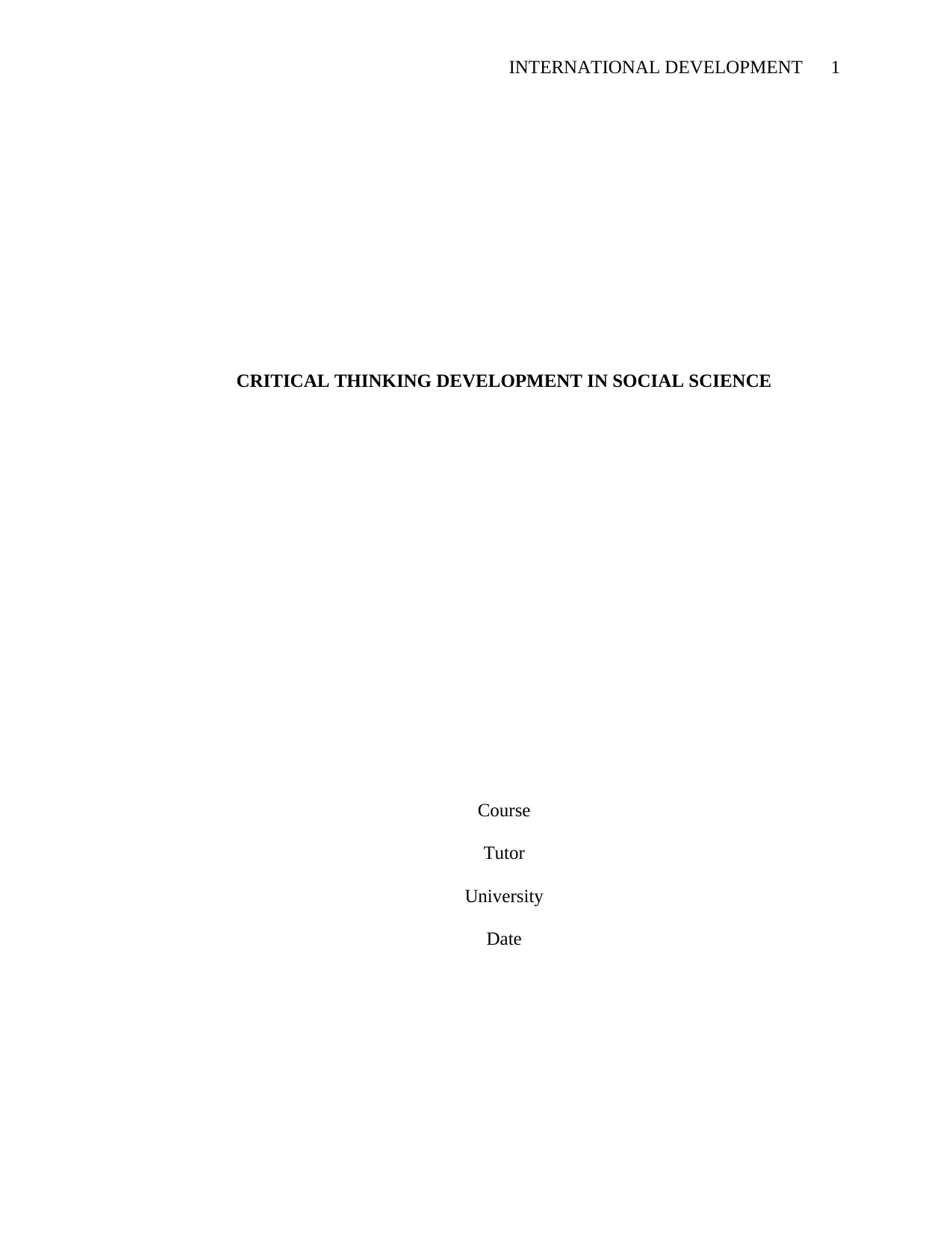
INTERNATIONAL DEVELOPMENT 1
CRITICAL THINKING DEVELOPMENT IN SOCIAL SCIENCE
Course
Tutor
University
Date
CRITICAL THINKING DEVELOPMENT IN SOCIAL SCIENCE
Course
Tutor
University
Date
Secure Best Marks with AI Grader
Need help grading? Try our AI Grader for instant feedback on your assignments.

INTERNATIONAL DEVELOPMENT 2
Contemporary development thinking entails modern concepts relating to growth or direct
change of the thinking faculties. Further, it involves identification of current challenges,
strengths, and weaknesses relating to key institutions that negatively influence the development
practice. The concepts allow thinkers and students to pass through developmental stages of
critical thinking and discuss key issues concerning the modern environment. For instance,
contemporary critical thinking in higher education allows the professionals to solve problems
about the field. In this case, problems affecting the colleges and universities include the costly
educational measures, and educational practices, among others (Nailya, Anna & Aida, 2015, p.
806). That means, in order to prepare students for the professional fields, tutors must develop
contemporary education systems which develop the systematic thinking for the graduates.
Examples of approaches include: increasing the multidisciplinary classes in terms of the diversity
of class participants and the type of courses offered; creating a multi-angle vision for
professional challenges involving societal, professional and anthropomorphic aspects; and
educating them on the anthropomorphic influence of individual solutions on the firm’s
challenges. By implementing such approaches, the levels of diversity in higher education
improve concerning the hands-on approach to finding solutions and multidisciplinary activities.
Other activities which improve the contemporary thinking among graduates include case studies,
project-based education, internships, role play, and virtual reality development.
According to (Mark, 2010: p. 60) contemporary development thinking suggests a
productive framework detailing policies, programs, and research creating an understanding of the
adolescent, positive and healthy development of adults. Notably, the contemporary theory
explains that different levels of organizations relating to human life (such as culture, biology,
history and natural ecology) feature as part of the ontogeny. The relations within the
Contemporary development thinking entails modern concepts relating to growth or direct
change of the thinking faculties. Further, it involves identification of current challenges,
strengths, and weaknesses relating to key institutions that negatively influence the development
practice. The concepts allow thinkers and students to pass through developmental stages of
critical thinking and discuss key issues concerning the modern environment. For instance,
contemporary critical thinking in higher education allows the professionals to solve problems
about the field. In this case, problems affecting the colleges and universities include the costly
educational measures, and educational practices, among others (Nailya, Anna & Aida, 2015, p.
806). That means, in order to prepare students for the professional fields, tutors must develop
contemporary education systems which develop the systematic thinking for the graduates.
Examples of approaches include: increasing the multidisciplinary classes in terms of the diversity
of class participants and the type of courses offered; creating a multi-angle vision for
professional challenges involving societal, professional and anthropomorphic aspects; and
educating them on the anthropomorphic influence of individual solutions on the firm’s
challenges. By implementing such approaches, the levels of diversity in higher education
improve concerning the hands-on approach to finding solutions and multidisciplinary activities.
Other activities which improve the contemporary thinking among graduates include case studies,
project-based education, internships, role play, and virtual reality development.
According to (Mark, 2010: p. 60) contemporary development thinking suggests a
productive framework detailing policies, programs, and research creating an understanding of the
adolescent, positive and healthy development of adults. Notably, the contemporary theory
explains that different levels of organizations relating to human life (such as culture, biology,
history and natural ecology) feature as part of the ontogeny. The relations within the
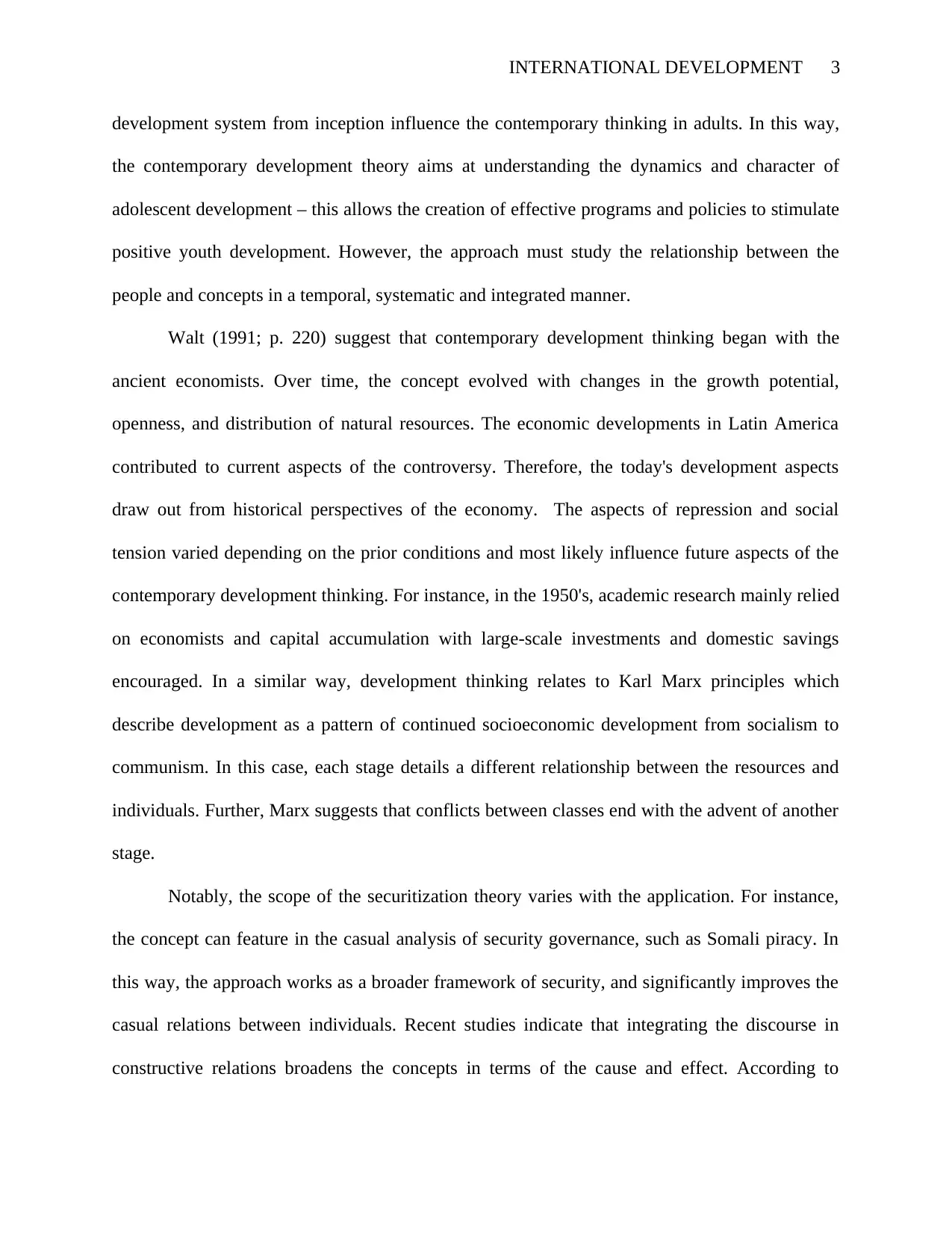
INTERNATIONAL DEVELOPMENT 3
development system from inception influence the contemporary thinking in adults. In this way,
the contemporary development theory aims at understanding the dynamics and character of
adolescent development – this allows the creation of effective programs and policies to stimulate
positive youth development. However, the approach must study the relationship between the
people and concepts in a temporal, systematic and integrated manner.
Walt (1991; p. 220) suggest that contemporary development thinking began with the
ancient economists. Over time, the concept evolved with changes in the growth potential,
openness, and distribution of natural resources. The economic developments in Latin America
contributed to current aspects of the controversy. Therefore, the today's development aspects
draw out from historical perspectives of the economy. The aspects of repression and social
tension varied depending on the prior conditions and most likely influence future aspects of the
contemporary development thinking. For instance, in the 1950's, academic research mainly relied
on economists and capital accumulation with large-scale investments and domestic savings
encouraged. In a similar way, development thinking relates to Karl Marx principles which
describe development as a pattern of continued socioeconomic development from socialism to
communism. In this case, each stage details a different relationship between the resources and
individuals. Further, Marx suggests that conflicts between classes end with the advent of another
stage.
Notably, the scope of the securitization theory varies with the application. For instance,
the concept can feature in the casual analysis of security governance, such as Somali piracy. In
this way, the approach works as a broader framework of security, and significantly improves the
casual relations between individuals. Recent studies indicate that integrating the discourse in
constructive relations broadens the concepts in terms of the cause and effect. According to
development system from inception influence the contemporary thinking in adults. In this way,
the contemporary development theory aims at understanding the dynamics and character of
adolescent development – this allows the creation of effective programs and policies to stimulate
positive youth development. However, the approach must study the relationship between the
people and concepts in a temporal, systematic and integrated manner.
Walt (1991; p. 220) suggest that contemporary development thinking began with the
ancient economists. Over time, the concept evolved with changes in the growth potential,
openness, and distribution of natural resources. The economic developments in Latin America
contributed to current aspects of the controversy. Therefore, the today's development aspects
draw out from historical perspectives of the economy. The aspects of repression and social
tension varied depending on the prior conditions and most likely influence future aspects of the
contemporary development thinking. For instance, in the 1950's, academic research mainly relied
on economists and capital accumulation with large-scale investments and domestic savings
encouraged. In a similar way, development thinking relates to Karl Marx principles which
describe development as a pattern of continued socioeconomic development from socialism to
communism. In this case, each stage details a different relationship between the resources and
individuals. Further, Marx suggests that conflicts between classes end with the advent of another
stage.
Notably, the scope of the securitization theory varies with the application. For instance,
the concept can feature in the casual analysis of security governance, such as Somali piracy. In
this way, the approach works as a broader framework of security, and significantly improves the
casual relations between individuals. Recent studies indicate that integrating the discourse in
constructive relations broadens the concepts in terms of the cause and effect. According to
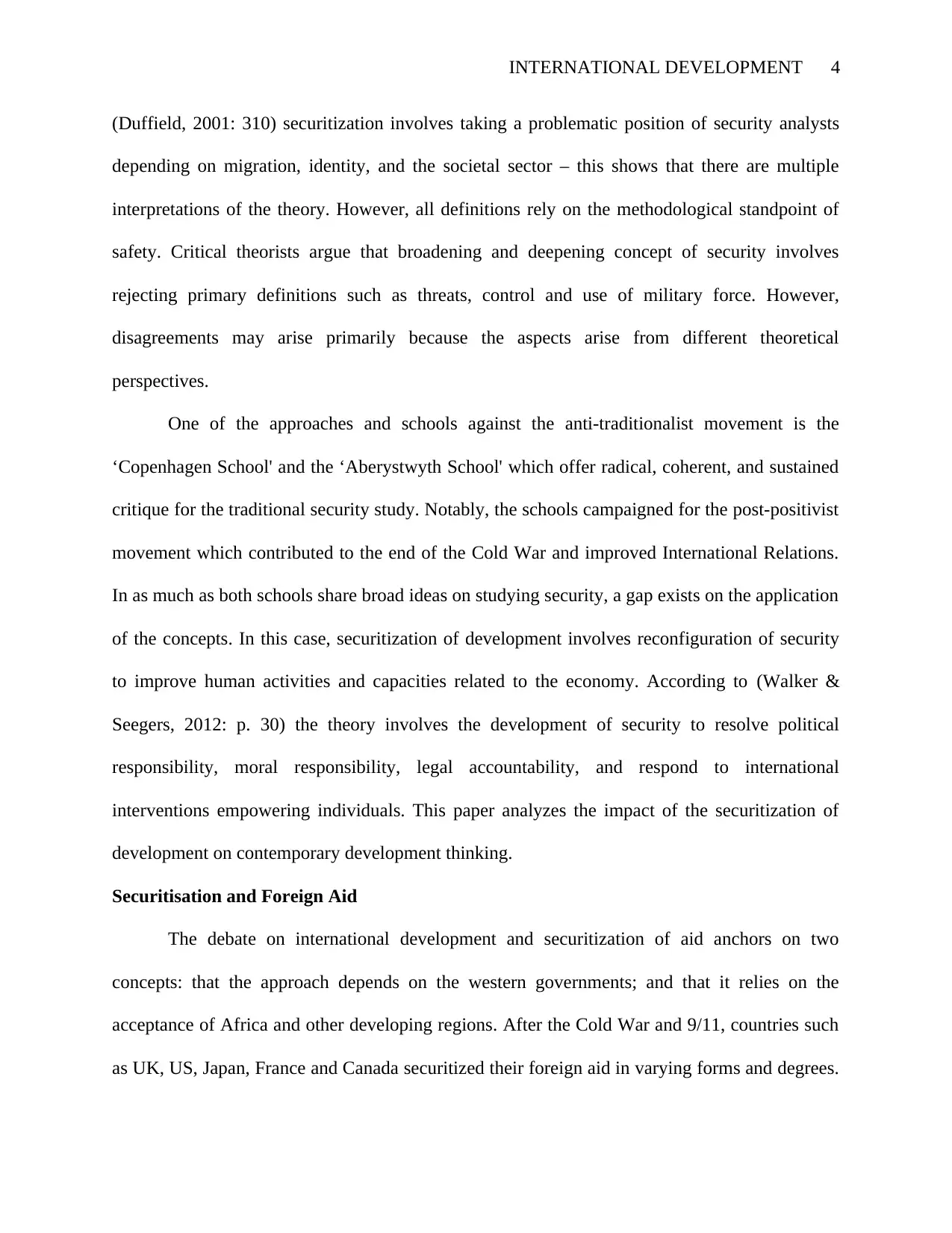
INTERNATIONAL DEVELOPMENT 4
(Duffield, 2001: 310) securitization involves taking a problematic position of security analysts
depending on migration, identity, and the societal sector – this shows that there are multiple
interpretations of the theory. However, all definitions rely on the methodological standpoint of
safety. Critical theorists argue that broadening and deepening concept of security involves
rejecting primary definitions such as threats, control and use of military force. However,
disagreements may arise primarily because the aspects arise from different theoretical
perspectives.
One of the approaches and schools against the anti-traditionalist movement is the
‘Copenhagen School' and the ‘Aberystwyth School' which offer radical, coherent, and sustained
critique for the traditional security study. Notably, the schools campaigned for the post-positivist
movement which contributed to the end of the Cold War and improved International Relations.
In as much as both schools share broad ideas on studying security, a gap exists on the application
of the concepts. In this case, securitization of development involves reconfiguration of security
to improve human activities and capacities related to the economy. According to (Walker &
Seegers, 2012: p. 30) the theory involves the development of security to resolve political
responsibility, moral responsibility, legal accountability, and respond to international
interventions empowering individuals. This paper analyzes the impact of the securitization of
development on contemporary development thinking.
Securitisation and Foreign Aid
The debate on international development and securitization of aid anchors on two
concepts: that the approach depends on the western governments; and that it relies on the
acceptance of Africa and other developing regions. After the Cold War and 9/11, countries such
as UK, US, Japan, France and Canada securitized their foreign aid in varying forms and degrees.
(Duffield, 2001: 310) securitization involves taking a problematic position of security analysts
depending on migration, identity, and the societal sector – this shows that there are multiple
interpretations of the theory. However, all definitions rely on the methodological standpoint of
safety. Critical theorists argue that broadening and deepening concept of security involves
rejecting primary definitions such as threats, control and use of military force. However,
disagreements may arise primarily because the aspects arise from different theoretical
perspectives.
One of the approaches and schools against the anti-traditionalist movement is the
‘Copenhagen School' and the ‘Aberystwyth School' which offer radical, coherent, and sustained
critique for the traditional security study. Notably, the schools campaigned for the post-positivist
movement which contributed to the end of the Cold War and improved International Relations.
In as much as both schools share broad ideas on studying security, a gap exists on the application
of the concepts. In this case, securitization of development involves reconfiguration of security
to improve human activities and capacities related to the economy. According to (Walker &
Seegers, 2012: p. 30) the theory involves the development of security to resolve political
responsibility, moral responsibility, legal accountability, and respond to international
interventions empowering individuals. This paper analyzes the impact of the securitization of
development on contemporary development thinking.
Securitisation and Foreign Aid
The debate on international development and securitization of aid anchors on two
concepts: that the approach depends on the western governments; and that it relies on the
acceptance of Africa and other developing regions. After the Cold War and 9/11, countries such
as UK, US, Japan, France and Canada securitized their foreign aid in varying forms and degrees.
Secure Best Marks with AI Grader
Need help grading? Try our AI Grader for instant feedback on your assignments.
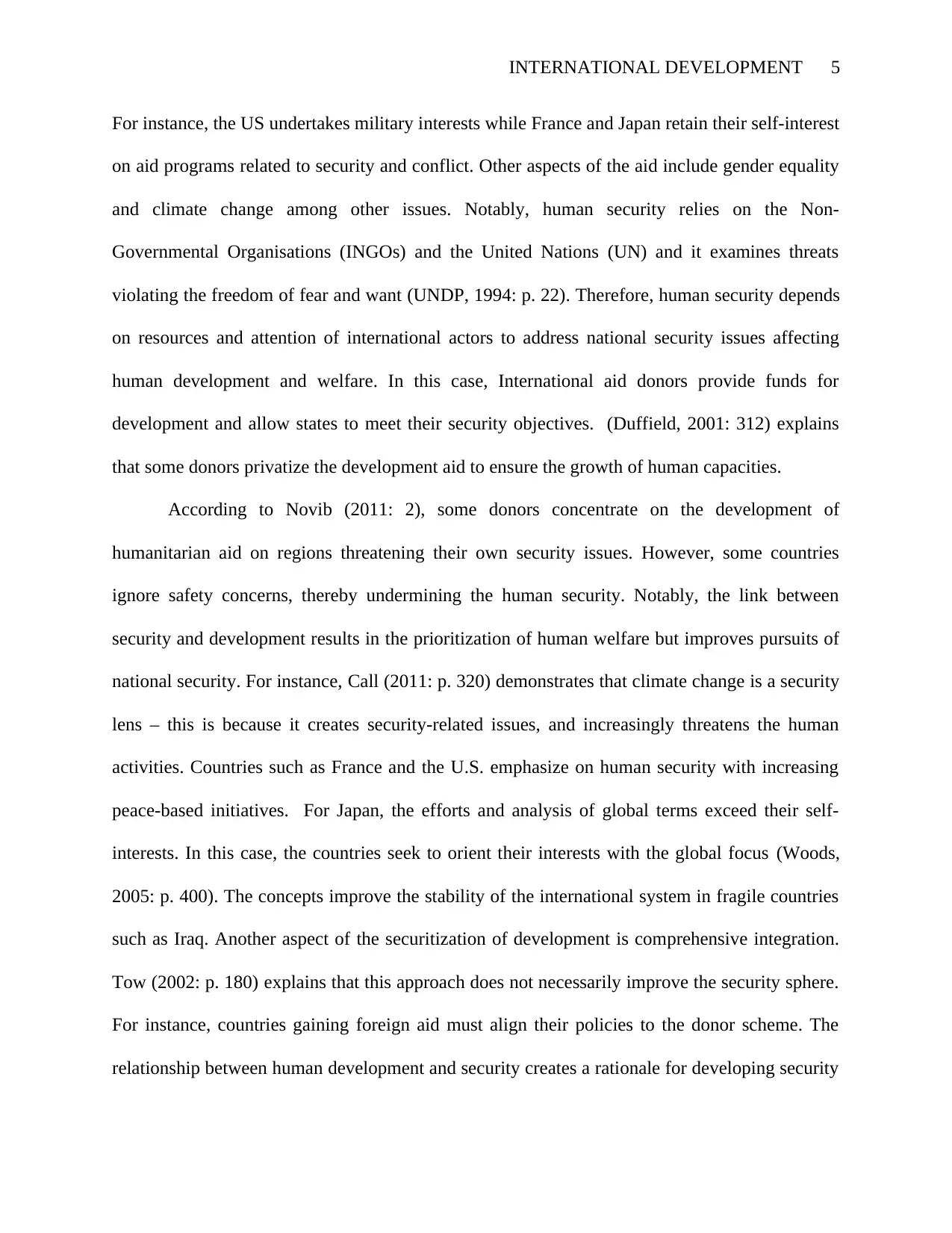
INTERNATIONAL DEVELOPMENT 5
For instance, the US undertakes military interests while France and Japan retain their self-interest
on aid programs related to security and conflict. Other aspects of the aid include gender equality
and climate change among other issues. Notably, human security relies on the Non-
Governmental Organisations (INGOs) and the United Nations (UN) and it examines threats
violating the freedom of fear and want (UNDP, 1994: p. 22). Therefore, human security depends
on resources and attention of international actors to address national security issues affecting
human development and welfare. In this case, International aid donors provide funds for
development and allow states to meet their security objectives. (Duffield, 2001: 312) explains
that some donors privatize the development aid to ensure the growth of human capacities.
According to Novib (2011: 2), some donors concentrate on the development of
humanitarian aid on regions threatening their own security issues. However, some countries
ignore safety concerns, thereby undermining the human security. Notably, the link between
security and development results in the prioritization of human welfare but improves pursuits of
national security. For instance, Call (2011: p. 320) demonstrates that climate change is a security
lens – this is because it creates security-related issues, and increasingly threatens the human
activities. Countries such as France and the U.S. emphasize on human security with increasing
peace-based initiatives. For Japan, the efforts and analysis of global terms exceed their self-
interests. In this case, the countries seek to orient their interests with the global focus (Woods,
2005: p. 400). The concepts improve the stability of the international system in fragile countries
such as Iraq. Another aspect of the securitization of development is comprehensive integration.
Tow (2002: p. 180) explains that this approach does not necessarily improve the security sphere.
For instance, countries gaining foreign aid must align their policies to the donor scheme. The
relationship between human development and security creates a rationale for developing security
For instance, the US undertakes military interests while France and Japan retain their self-interest
on aid programs related to security and conflict. Other aspects of the aid include gender equality
and climate change among other issues. Notably, human security relies on the Non-
Governmental Organisations (INGOs) and the United Nations (UN) and it examines threats
violating the freedom of fear and want (UNDP, 1994: p. 22). Therefore, human security depends
on resources and attention of international actors to address national security issues affecting
human development and welfare. In this case, International aid donors provide funds for
development and allow states to meet their security objectives. (Duffield, 2001: 312) explains
that some donors privatize the development aid to ensure the growth of human capacities.
According to Novib (2011: 2), some donors concentrate on the development of
humanitarian aid on regions threatening their own security issues. However, some countries
ignore safety concerns, thereby undermining the human security. Notably, the link between
security and development results in the prioritization of human welfare but improves pursuits of
national security. For instance, Call (2011: p. 320) demonstrates that climate change is a security
lens – this is because it creates security-related issues, and increasingly threatens the human
activities. Countries such as France and the U.S. emphasize on human security with increasing
peace-based initiatives. For Japan, the efforts and analysis of global terms exceed their self-
interests. In this case, the countries seek to orient their interests with the global focus (Woods,
2005: p. 400). The concepts improve the stability of the international system in fragile countries
such as Iraq. Another aspect of the securitization of development is comprehensive integration.
Tow (2002: p. 180) explains that this approach does not necessarily improve the security sphere.
For instance, countries gaining foreign aid must align their policies to the donor scheme. The
relationship between human development and security creates a rationale for developing security
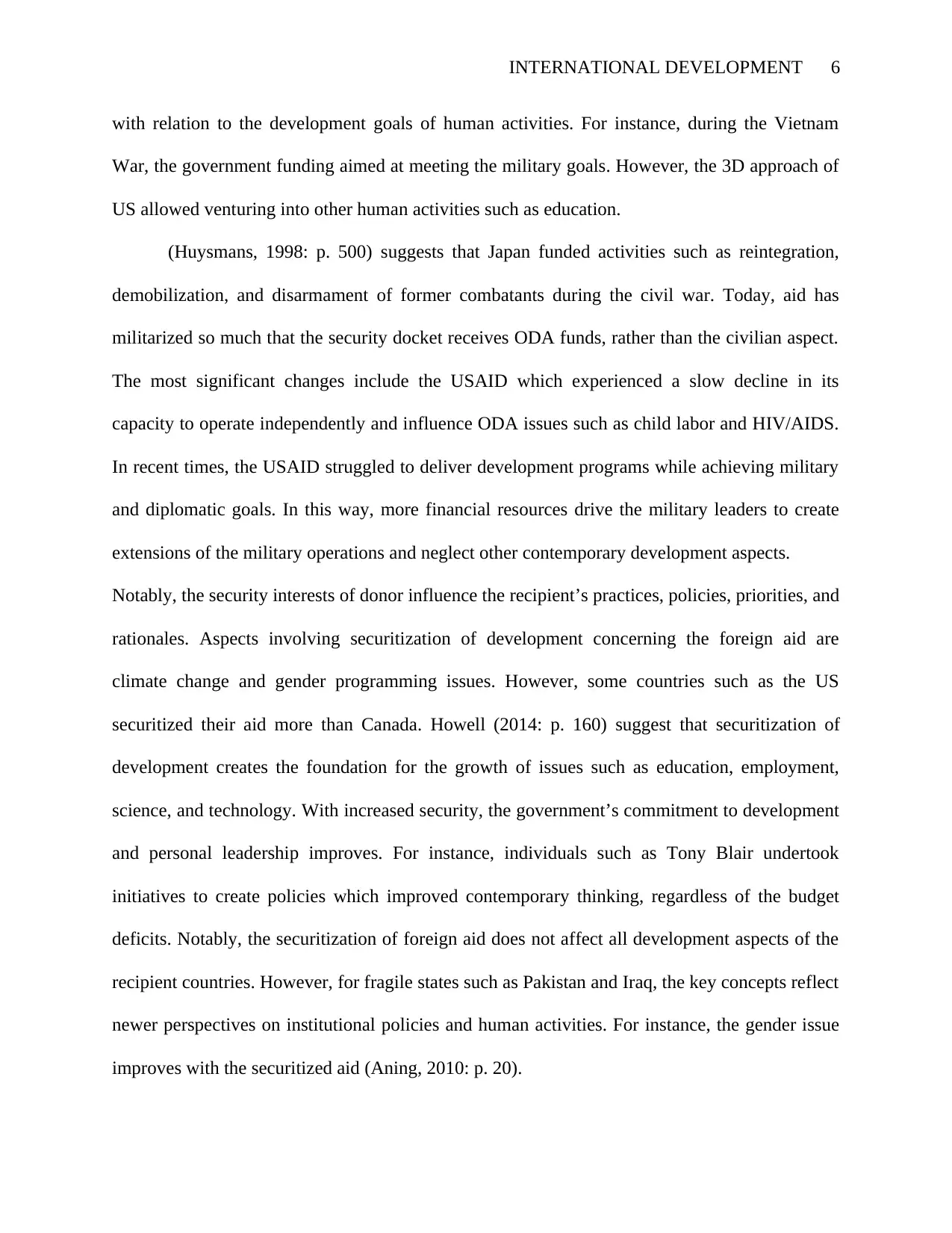
INTERNATIONAL DEVELOPMENT 6
with relation to the development goals of human activities. For instance, during the Vietnam
War, the government funding aimed at meeting the military goals. However, the 3D approach of
US allowed venturing into other human activities such as education.
(Huysmans, 1998: p. 500) suggests that Japan funded activities such as reintegration,
demobilization, and disarmament of former combatants during the civil war. Today, aid has
militarized so much that the security docket receives ODA funds, rather than the civilian aspect.
The most significant changes include the USAID which experienced a slow decline in its
capacity to operate independently and influence ODA issues such as child labor and HIV/AIDS.
In recent times, the USAID struggled to deliver development programs while achieving military
and diplomatic goals. In this way, more financial resources drive the military leaders to create
extensions of the military operations and neglect other contemporary development aspects.
Notably, the security interests of donor influence the recipient’s practices, policies, priorities, and
rationales. Aspects involving securitization of development concerning the foreign aid are
climate change and gender programming issues. However, some countries such as the US
securitized their aid more than Canada. Howell (2014: p. 160) suggest that securitization of
development creates the foundation for the growth of issues such as education, employment,
science, and technology. With increased security, the government’s commitment to development
and personal leadership improves. For instance, individuals such as Tony Blair undertook
initiatives to create policies which improved contemporary thinking, regardless of the budget
deficits. Notably, the securitization of foreign aid does not affect all development aspects of the
recipient countries. However, for fragile states such as Pakistan and Iraq, the key concepts reflect
newer perspectives on institutional policies and human activities. For instance, the gender issue
improves with the securitized aid (Aning, 2010: p. 20).
with relation to the development goals of human activities. For instance, during the Vietnam
War, the government funding aimed at meeting the military goals. However, the 3D approach of
US allowed venturing into other human activities such as education.
(Huysmans, 1998: p. 500) suggests that Japan funded activities such as reintegration,
demobilization, and disarmament of former combatants during the civil war. Today, aid has
militarized so much that the security docket receives ODA funds, rather than the civilian aspect.
The most significant changes include the USAID which experienced a slow decline in its
capacity to operate independently and influence ODA issues such as child labor and HIV/AIDS.
In recent times, the USAID struggled to deliver development programs while achieving military
and diplomatic goals. In this way, more financial resources drive the military leaders to create
extensions of the military operations and neglect other contemporary development aspects.
Notably, the security interests of donor influence the recipient’s practices, policies, priorities, and
rationales. Aspects involving securitization of development concerning the foreign aid are
climate change and gender programming issues. However, some countries such as the US
securitized their aid more than Canada. Howell (2014: p. 160) suggest that securitization of
development creates the foundation for the growth of issues such as education, employment,
science, and technology. With increased security, the government’s commitment to development
and personal leadership improves. For instance, individuals such as Tony Blair undertook
initiatives to create policies which improved contemporary thinking, regardless of the budget
deficits. Notably, the securitization of foreign aid does not affect all development aspects of the
recipient countries. However, for fragile states such as Pakistan and Iraq, the key concepts reflect
newer perspectives on institutional policies and human activities. For instance, the gender issue
improves with the securitized aid (Aning, 2010: p. 20).
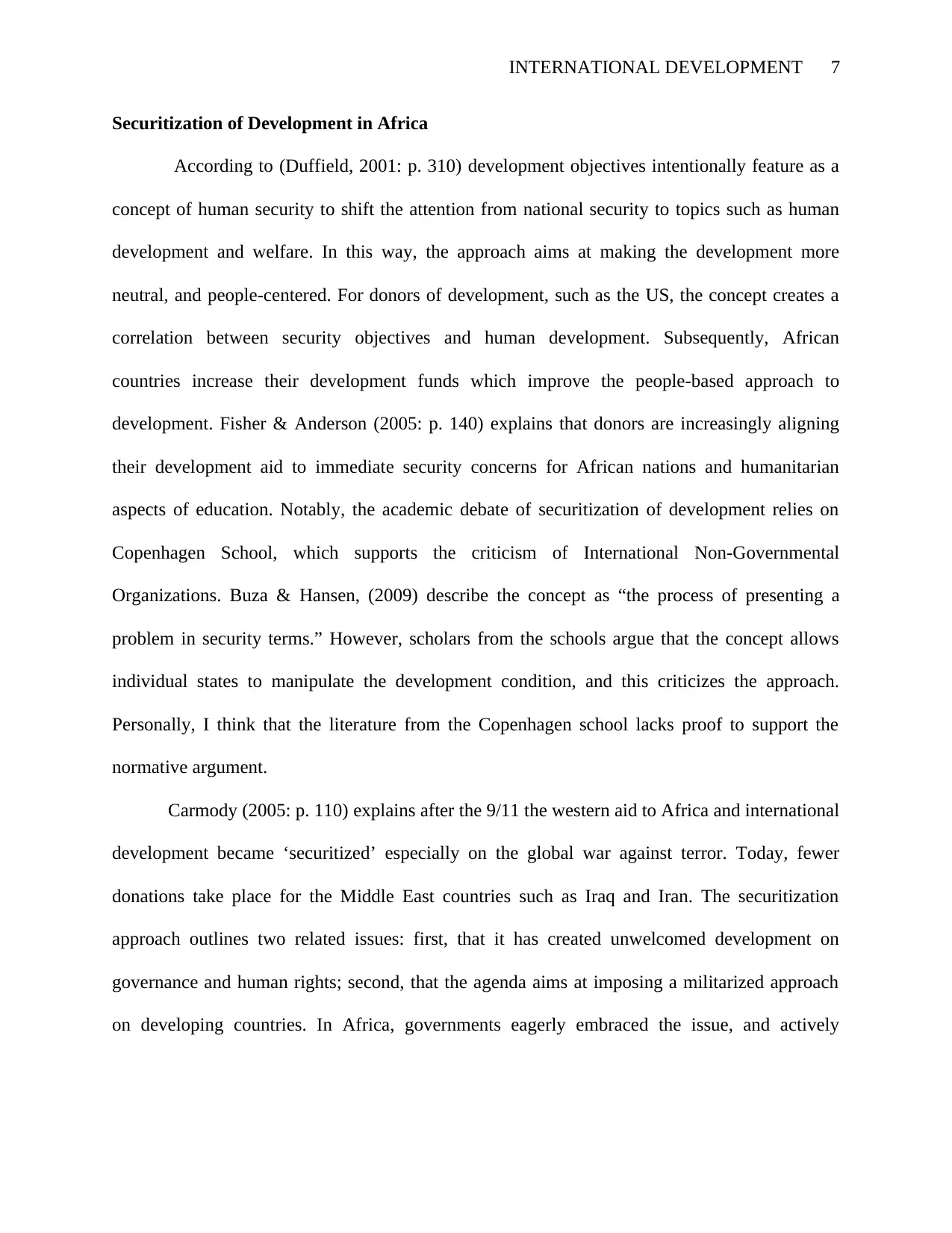
INTERNATIONAL DEVELOPMENT 7
Securitization of Development in Africa
According to (Duffield, 2001: p. 310) development objectives intentionally feature as a
concept of human security to shift the attention from national security to topics such as human
development and welfare. In this way, the approach aims at making the development more
neutral, and people-centered. For donors of development, such as the US, the concept creates a
correlation between security objectives and human development. Subsequently, African
countries increase their development funds which improve the people-based approach to
development. Fisher & Anderson (2005: p. 140) explains that donors are increasingly aligning
their development aid to immediate security concerns for African nations and humanitarian
aspects of education. Notably, the academic debate of securitization of development relies on
Copenhagen School, which supports the criticism of International Non-Governmental
Organizations. Buza & Hansen, (2009) describe the concept as “the process of presenting a
problem in security terms.” However, scholars from the schools argue that the concept allows
individual states to manipulate the development condition, and this criticizes the approach.
Personally, I think that the literature from the Copenhagen school lacks proof to support the
normative argument.
Carmody (2005: p. 110) explains after the 9/11 the western aid to Africa and international
development became ‘securitized’ especially on the global war against terror. Today, fewer
donations take place for the Middle East countries such as Iraq and Iran. The securitization
approach outlines two related issues: first, that it has created unwelcomed development on
governance and human rights; second, that the agenda aims at imposing a militarized approach
on developing countries. In Africa, governments eagerly embraced the issue, and actively
Securitization of Development in Africa
According to (Duffield, 2001: p. 310) development objectives intentionally feature as a
concept of human security to shift the attention from national security to topics such as human
development and welfare. In this way, the approach aims at making the development more
neutral, and people-centered. For donors of development, such as the US, the concept creates a
correlation between security objectives and human development. Subsequently, African
countries increase their development funds which improve the people-based approach to
development. Fisher & Anderson (2005: p. 140) explains that donors are increasingly aligning
their development aid to immediate security concerns for African nations and humanitarian
aspects of education. Notably, the academic debate of securitization of development relies on
Copenhagen School, which supports the criticism of International Non-Governmental
Organizations. Buza & Hansen, (2009) describe the concept as “the process of presenting a
problem in security terms.” However, scholars from the schools argue that the concept allows
individual states to manipulate the development condition, and this criticizes the approach.
Personally, I think that the literature from the Copenhagen school lacks proof to support the
normative argument.
Carmody (2005: p. 110) explains after the 9/11 the western aid to Africa and international
development became ‘securitized’ especially on the global war against terror. Today, fewer
donations take place for the Middle East countries such as Iraq and Iran. The securitization
approach outlines two related issues: first, that it has created unwelcomed development on
governance and human rights; second, that the agenda aims at imposing a militarized approach
on developing countries. In Africa, governments eagerly embraced the issue, and actively
Paraphrase This Document
Need a fresh take? Get an instant paraphrase of this document with our AI Paraphraser
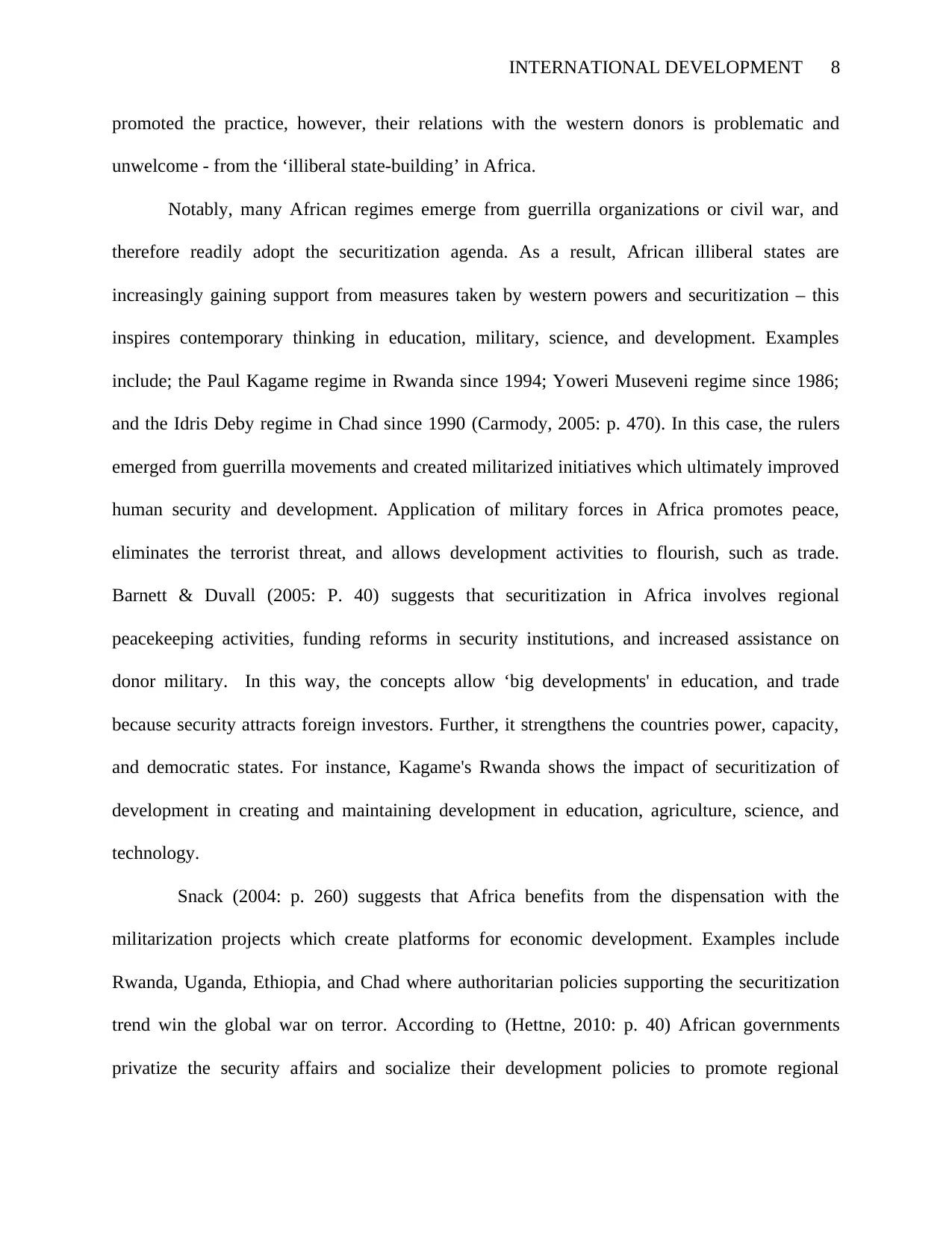
INTERNATIONAL DEVELOPMENT 8
promoted the practice, however, their relations with the western donors is problematic and
unwelcome - from the ‘illiberal state-building’ in Africa.
Notably, many African regimes emerge from guerrilla organizations or civil war, and
therefore readily adopt the securitization agenda. As a result, African illiberal states are
increasingly gaining support from measures taken by western powers and securitization – this
inspires contemporary thinking in education, military, science, and development. Examples
include; the Paul Kagame regime in Rwanda since 1994; Yoweri Museveni regime since 1986;
and the Idris Deby regime in Chad since 1990 (Carmody, 2005: p. 470). In this case, the rulers
emerged from guerrilla movements and created militarized initiatives which ultimately improved
human security and development. Application of military forces in Africa promotes peace,
eliminates the terrorist threat, and allows development activities to flourish, such as trade.
Barnett & Duvall (2005: P. 40) suggests that securitization in Africa involves regional
peacekeeping activities, funding reforms in security institutions, and increased assistance on
donor military. In this way, the concepts allow ‘big developments' in education, and trade
because security attracts foreign investors. Further, it strengthens the countries power, capacity,
and democratic states. For instance, Kagame's Rwanda shows the impact of securitization of
development in creating and maintaining development in education, agriculture, science, and
technology.
Snack (2004: p. 260) suggests that Africa benefits from the dispensation with the
militarization projects which create platforms for economic development. Examples include
Rwanda, Uganda, Ethiopia, and Chad where authoritarian policies supporting the securitization
trend win the global war on terror. According to (Hettne, 2010: p. 40) African governments
privatize the security affairs and socialize their development policies to promote regional
promoted the practice, however, their relations with the western donors is problematic and
unwelcome - from the ‘illiberal state-building’ in Africa.
Notably, many African regimes emerge from guerrilla organizations or civil war, and
therefore readily adopt the securitization agenda. As a result, African illiberal states are
increasingly gaining support from measures taken by western powers and securitization – this
inspires contemporary thinking in education, military, science, and development. Examples
include; the Paul Kagame regime in Rwanda since 1994; Yoweri Museveni regime since 1986;
and the Idris Deby regime in Chad since 1990 (Carmody, 2005: p. 470). In this case, the rulers
emerged from guerrilla movements and created militarized initiatives which ultimately improved
human security and development. Application of military forces in Africa promotes peace,
eliminates the terrorist threat, and allows development activities to flourish, such as trade.
Barnett & Duvall (2005: P. 40) suggests that securitization in Africa involves regional
peacekeeping activities, funding reforms in security institutions, and increased assistance on
donor military. In this way, the concepts allow ‘big developments' in education, and trade
because security attracts foreign investors. Further, it strengthens the countries power, capacity,
and democratic states. For instance, Kagame's Rwanda shows the impact of securitization of
development in creating and maintaining development in education, agriculture, science, and
technology.
Snack (2004: p. 260) suggests that Africa benefits from the dispensation with the
militarization projects which create platforms for economic development. Examples include
Rwanda, Uganda, Ethiopia, and Chad where authoritarian policies supporting the securitization
trend win the global war on terror. According to (Hettne, 2010: p. 40) African governments
privatize the security affairs and socialize their development policies to promote regional
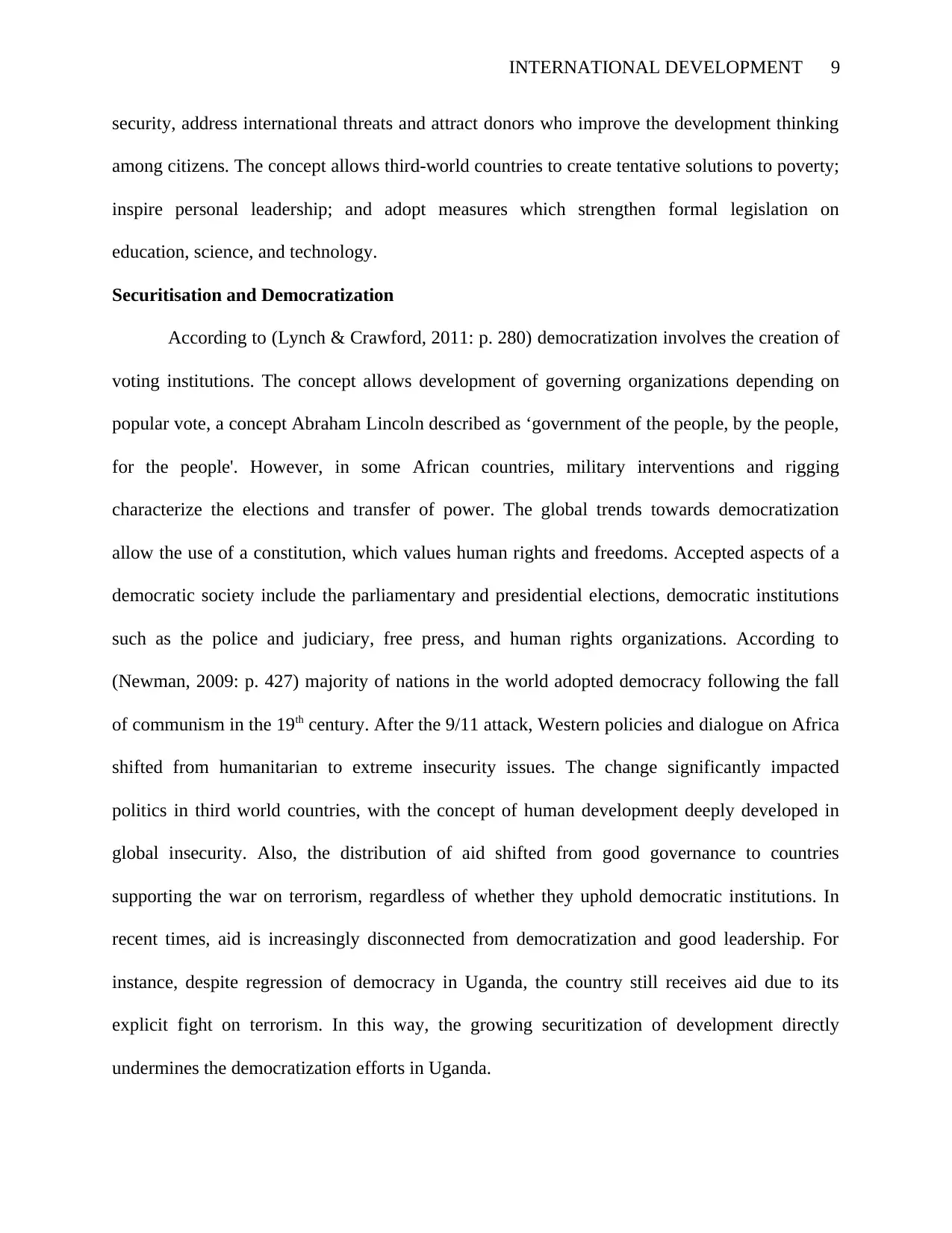
INTERNATIONAL DEVELOPMENT 9
security, address international threats and attract donors who improve the development thinking
among citizens. The concept allows third-world countries to create tentative solutions to poverty;
inspire personal leadership; and adopt measures which strengthen formal legislation on
education, science, and technology.
Securitisation and Democratization
According to (Lynch & Crawford, 2011: p. 280) democratization involves the creation of
voting institutions. The concept allows development of governing organizations depending on
popular vote, a concept Abraham Lincoln described as ‘government of the people, by the people,
for the people'. However, in some African countries, military interventions and rigging
characterize the elections and transfer of power. The global trends towards democratization
allow the use of a constitution, which values human rights and freedoms. Accepted aspects of a
democratic society include the parliamentary and presidential elections, democratic institutions
such as the police and judiciary, free press, and human rights organizations. According to
(Newman, 2009: p. 427) majority of nations in the world adopted democracy following the fall
of communism in the 19th century. After the 9/11 attack, Western policies and dialogue on Africa
shifted from humanitarian to extreme insecurity issues. The change significantly impacted
politics in third world countries, with the concept of human development deeply developed in
global insecurity. Also, the distribution of aid shifted from good governance to countries
supporting the war on terrorism, regardless of whether they uphold democratic institutions. In
recent times, aid is increasingly disconnected from democratization and good leadership. For
instance, despite regression of democracy in Uganda, the country still receives aid due to its
explicit fight on terrorism. In this way, the growing securitization of development directly
undermines the democratization efforts in Uganda.
security, address international threats and attract donors who improve the development thinking
among citizens. The concept allows third-world countries to create tentative solutions to poverty;
inspire personal leadership; and adopt measures which strengthen formal legislation on
education, science, and technology.
Securitisation and Democratization
According to (Lynch & Crawford, 2011: p. 280) democratization involves the creation of
voting institutions. The concept allows development of governing organizations depending on
popular vote, a concept Abraham Lincoln described as ‘government of the people, by the people,
for the people'. However, in some African countries, military interventions and rigging
characterize the elections and transfer of power. The global trends towards democratization
allow the use of a constitution, which values human rights and freedoms. Accepted aspects of a
democratic society include the parliamentary and presidential elections, democratic institutions
such as the police and judiciary, free press, and human rights organizations. According to
(Newman, 2009: p. 427) majority of nations in the world adopted democracy following the fall
of communism in the 19th century. After the 9/11 attack, Western policies and dialogue on Africa
shifted from humanitarian to extreme insecurity issues. The change significantly impacted
politics in third world countries, with the concept of human development deeply developed in
global insecurity. Also, the distribution of aid shifted from good governance to countries
supporting the war on terrorism, regardless of whether they uphold democratic institutions. In
recent times, aid is increasingly disconnected from democratization and good leadership. For
instance, despite regression of democracy in Uganda, the country still receives aid due to its
explicit fight on terrorism. In this way, the growing securitization of development directly
undermines the democratization efforts in Uganda.
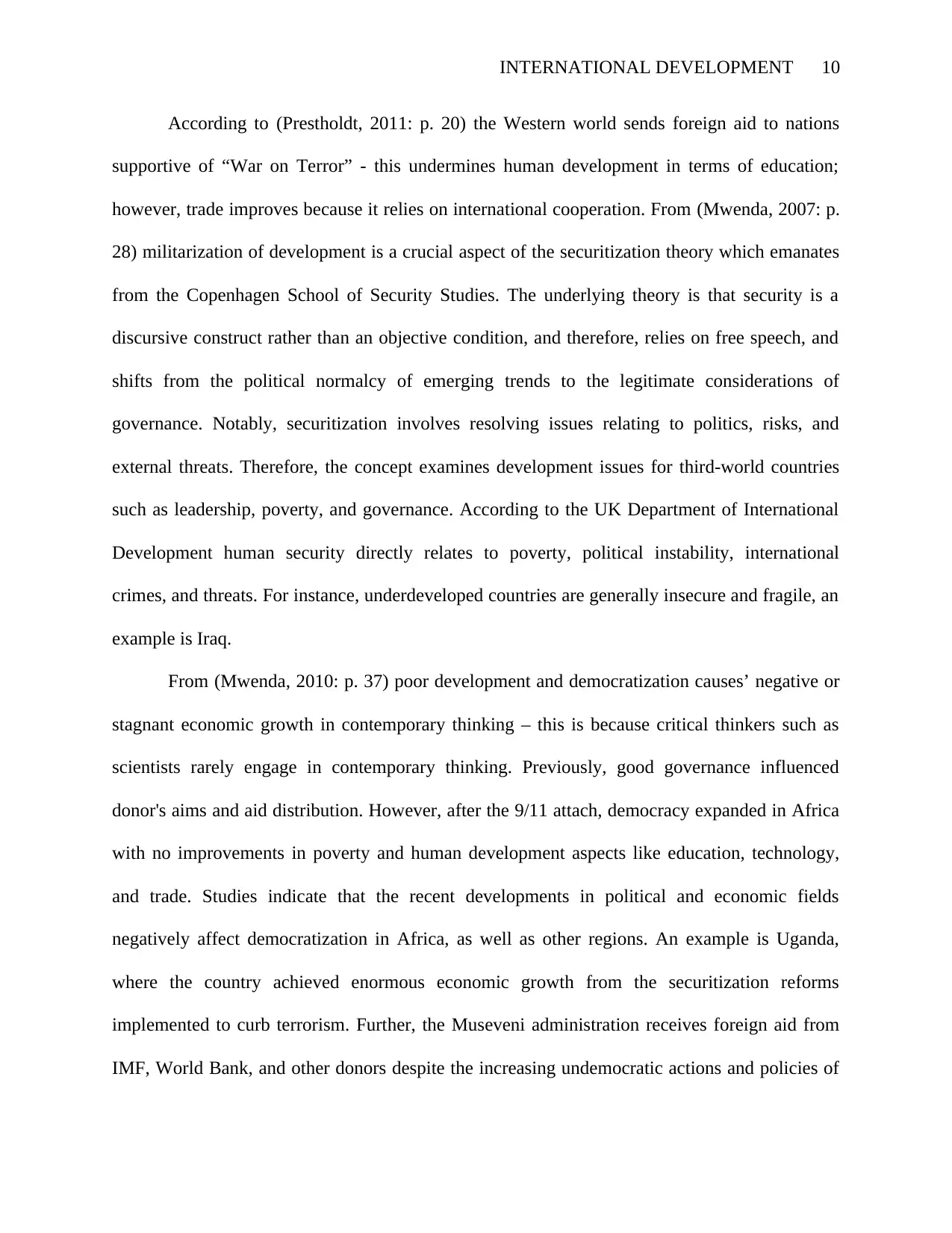
INTERNATIONAL DEVELOPMENT 10
According to (Prestholdt, 2011: p. 20) the Western world sends foreign aid to nations
supportive of “War on Terror” - this undermines human development in terms of education;
however, trade improves because it relies on international cooperation. From (Mwenda, 2007: p.
28) militarization of development is a crucial aspect of the securitization theory which emanates
from the Copenhagen School of Security Studies. The underlying theory is that security is a
discursive construct rather than an objective condition, and therefore, relies on free speech, and
shifts from the political normalcy of emerging trends to the legitimate considerations of
governance. Notably, securitization involves resolving issues relating to politics, risks, and
external threats. Therefore, the concept examines development issues for third-world countries
such as leadership, poverty, and governance. According to the UK Department of International
Development human security directly relates to poverty, political instability, international
crimes, and threats. For instance, underdeveloped countries are generally insecure and fragile, an
example is Iraq.
From (Mwenda, 2010: p. 37) poor development and democratization causes’ negative or
stagnant economic growth in contemporary thinking – this is because critical thinkers such as
scientists rarely engage in contemporary thinking. Previously, good governance influenced
donor's aims and aid distribution. However, after the 9/11 attach, democracy expanded in Africa
with no improvements in poverty and human development aspects like education, technology,
and trade. Studies indicate that the recent developments in political and economic fields
negatively affect democratization in Africa, as well as other regions. An example is Uganda,
where the country achieved enormous economic growth from the securitization reforms
implemented to curb terrorism. Further, the Museveni administration receives foreign aid from
IMF, World Bank, and other donors despite the increasing undemocratic actions and policies of
According to (Prestholdt, 2011: p. 20) the Western world sends foreign aid to nations
supportive of “War on Terror” - this undermines human development in terms of education;
however, trade improves because it relies on international cooperation. From (Mwenda, 2007: p.
28) militarization of development is a crucial aspect of the securitization theory which emanates
from the Copenhagen School of Security Studies. The underlying theory is that security is a
discursive construct rather than an objective condition, and therefore, relies on free speech, and
shifts from the political normalcy of emerging trends to the legitimate considerations of
governance. Notably, securitization involves resolving issues relating to politics, risks, and
external threats. Therefore, the concept examines development issues for third-world countries
such as leadership, poverty, and governance. According to the UK Department of International
Development human security directly relates to poverty, political instability, international
crimes, and threats. For instance, underdeveloped countries are generally insecure and fragile, an
example is Iraq.
From (Mwenda, 2010: p. 37) poor development and democratization causes’ negative or
stagnant economic growth in contemporary thinking – this is because critical thinkers such as
scientists rarely engage in contemporary thinking. Previously, good governance influenced
donor's aims and aid distribution. However, after the 9/11 attach, democracy expanded in Africa
with no improvements in poverty and human development aspects like education, technology,
and trade. Studies indicate that the recent developments in political and economic fields
negatively affect democratization in Africa, as well as other regions. An example is Uganda,
where the country achieved enormous economic growth from the securitization reforms
implemented to curb terrorism. Further, the Museveni administration receives foreign aid from
IMF, World Bank, and other donors despite the increasing undemocratic actions and policies of
Secure Best Marks with AI Grader
Need help grading? Try our AI Grader for instant feedback on your assignments.
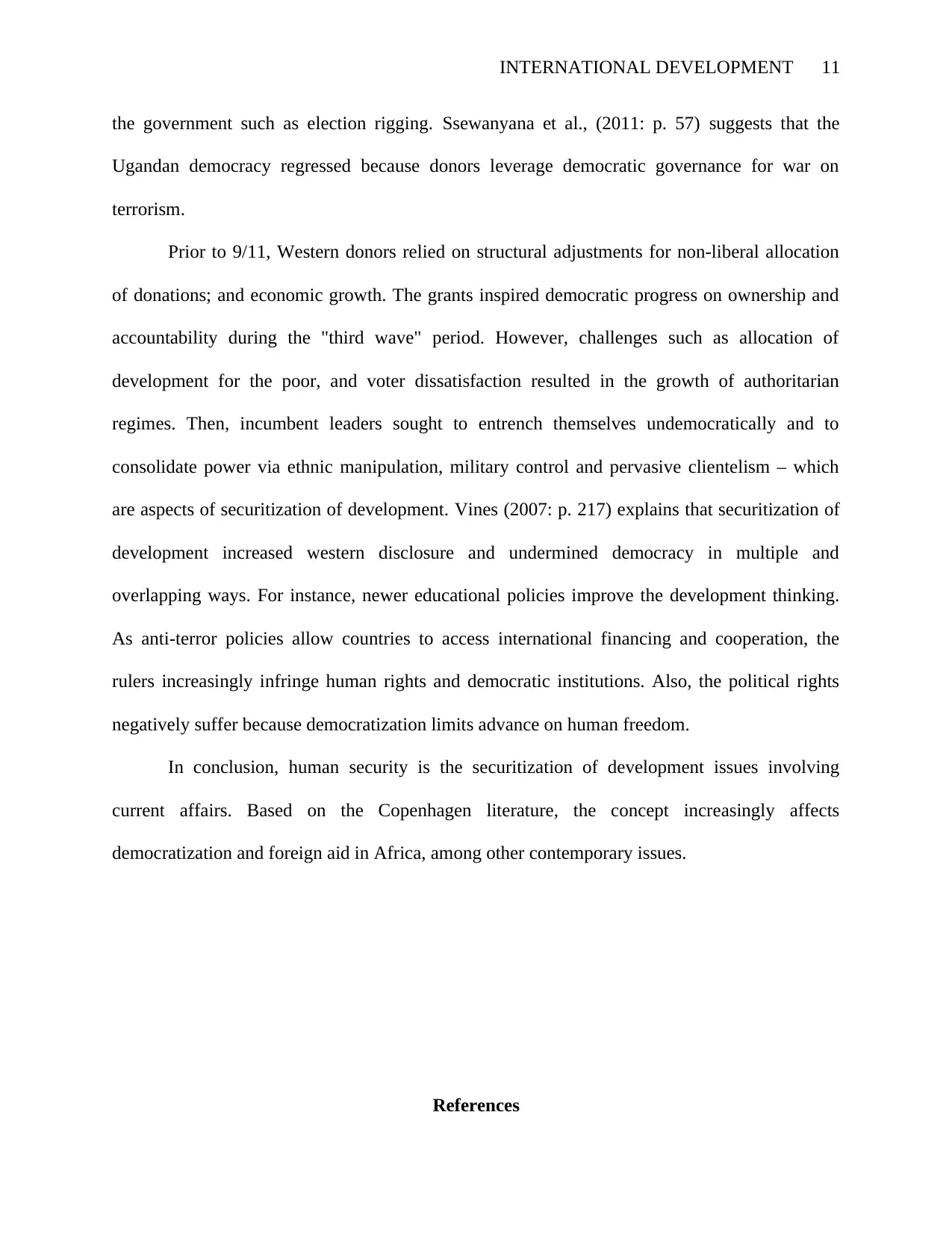
INTERNATIONAL DEVELOPMENT 11
the government such as election rigging. Ssewanyana et al., (2011: p. 57) suggests that the
Ugandan democracy regressed because donors leverage democratic governance for war on
terrorism.
Prior to 9/11, Western donors relied on structural adjustments for non-liberal allocation
of donations; and economic growth. The grants inspired democratic progress on ownership and
accountability during the "third wave" period. However, challenges such as allocation of
development for the poor, and voter dissatisfaction resulted in the growth of authoritarian
regimes. Then, incumbent leaders sought to entrench themselves undemocratically and to
consolidate power via ethnic manipulation, military control and pervasive clientelism – which
are aspects of securitization of development. Vines (2007: p. 217) explains that securitization of
development increased western disclosure and undermined democracy in multiple and
overlapping ways. For instance, newer educational policies improve the development thinking.
As anti-terror policies allow countries to access international financing and cooperation, the
rulers increasingly infringe human rights and democratic institutions. Also, the political rights
negatively suffer because democratization limits advance on human freedom.
In conclusion, human security is the securitization of development issues involving
current affairs. Based on the Copenhagen literature, the concept increasingly affects
democratization and foreign aid in Africa, among other contemporary issues.
References
the government such as election rigging. Ssewanyana et al., (2011: p. 57) suggests that the
Ugandan democracy regressed because donors leverage democratic governance for war on
terrorism.
Prior to 9/11, Western donors relied on structural adjustments for non-liberal allocation
of donations; and economic growth. The grants inspired democratic progress on ownership and
accountability during the "third wave" period. However, challenges such as allocation of
development for the poor, and voter dissatisfaction resulted in the growth of authoritarian
regimes. Then, incumbent leaders sought to entrench themselves undemocratically and to
consolidate power via ethnic manipulation, military control and pervasive clientelism – which
are aspects of securitization of development. Vines (2007: p. 217) explains that securitization of
development increased western disclosure and undermined democracy in multiple and
overlapping ways. For instance, newer educational policies improve the development thinking.
As anti-terror policies allow countries to access international financing and cooperation, the
rulers increasingly infringe human rights and democratic institutions. Also, the political rights
negatively suffer because democratization limits advance on human freedom.
In conclusion, human security is the securitization of development issues involving
current affairs. Based on the Copenhagen literature, the concept increasingly affects
democratization and foreign aid in Africa, among other contemporary issues.
References
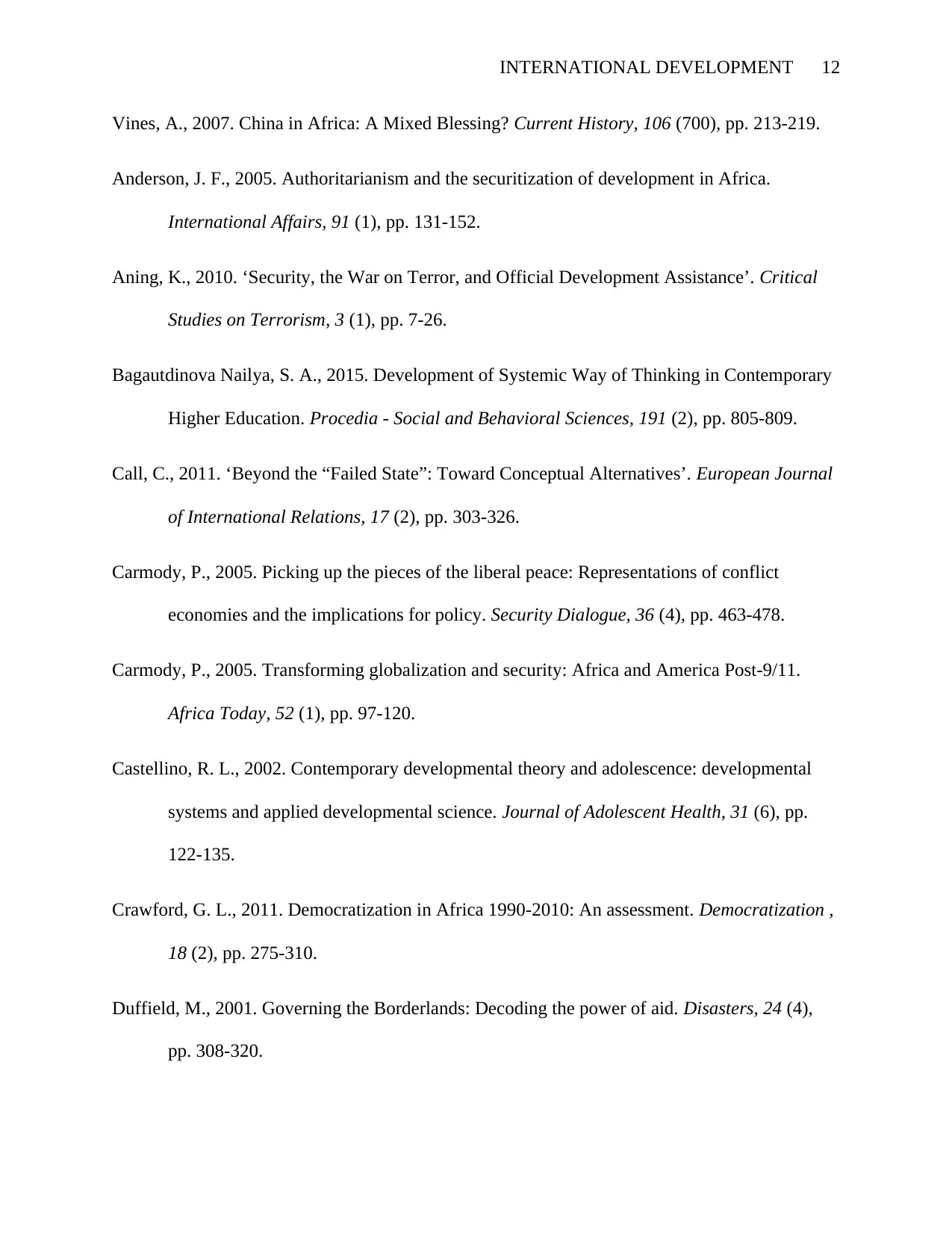
INTERNATIONAL DEVELOPMENT 12
Vines, A., 2007. China in Africa: A Mixed Blessing? Current History, 106 (700), pp. 213-219.
Anderson, J. F., 2005. Authoritarianism and the securitization of development in Africa.
International Affairs, 91 (1), pp. 131-152.
Aning, K., 2010. ‘Security, the War on Terror, and Official Development Assistance’. Critical
Studies on Terrorism, 3 (1), pp. 7-26.
Bagautdinova Nailya, S. A., 2015. Development of Systemic Way of Thinking in Contemporary
Higher Education. Procedia - Social and Behavioral Sciences, 191 (2), pp. 805-809.
Call, C., 2011. ‘Beyond the “Failed State”: Toward Conceptual Alternatives’. European Journal
of International Relations, 17 (2), pp. 303-326.
Carmody, P., 2005. Picking up the pieces of the liberal peace: Representations of conflict
economies and the implications for policy. Security Dialogue, 36 (4), pp. 463-478.
Carmody, P., 2005. Transforming globalization and security: Africa and America Post-9/11.
Africa Today, 52 (1), pp. 97-120.
Castellino, R. L., 2002. Contemporary developmental theory and adolescence: developmental
systems and applied developmental science. Journal of Adolescent Health, 31 (6), pp.
122-135.
Crawford, G. L., 2011. Democratization in Africa 1990-2010: An assessment. Democratization ,
18 (2), pp. 275-310.
Duffield, M., 2001. Governing the Borderlands: Decoding the power of aid. Disasters, 24 (4),
pp. 308-320.
Vines, A., 2007. China in Africa: A Mixed Blessing? Current History, 106 (700), pp. 213-219.
Anderson, J. F., 2005. Authoritarianism and the securitization of development in Africa.
International Affairs, 91 (1), pp. 131-152.
Aning, K., 2010. ‘Security, the War on Terror, and Official Development Assistance’. Critical
Studies on Terrorism, 3 (1), pp. 7-26.
Bagautdinova Nailya, S. A., 2015. Development of Systemic Way of Thinking in Contemporary
Higher Education. Procedia - Social and Behavioral Sciences, 191 (2), pp. 805-809.
Call, C., 2011. ‘Beyond the “Failed State”: Toward Conceptual Alternatives’. European Journal
of International Relations, 17 (2), pp. 303-326.
Carmody, P., 2005. Picking up the pieces of the liberal peace: Representations of conflict
economies and the implications for policy. Security Dialogue, 36 (4), pp. 463-478.
Carmody, P., 2005. Transforming globalization and security: Africa and America Post-9/11.
Africa Today, 52 (1), pp. 97-120.
Castellino, R. L., 2002. Contemporary developmental theory and adolescence: developmental
systems and applied developmental science. Journal of Adolescent Health, 31 (6), pp.
122-135.
Crawford, G. L., 2011. Democratization in Africa 1990-2010: An assessment. Democratization ,
18 (2), pp. 275-310.
Duffield, M., 2001. Governing the Borderlands: Decoding the power of aid. Disasters, 24 (4),
pp. 308-320.
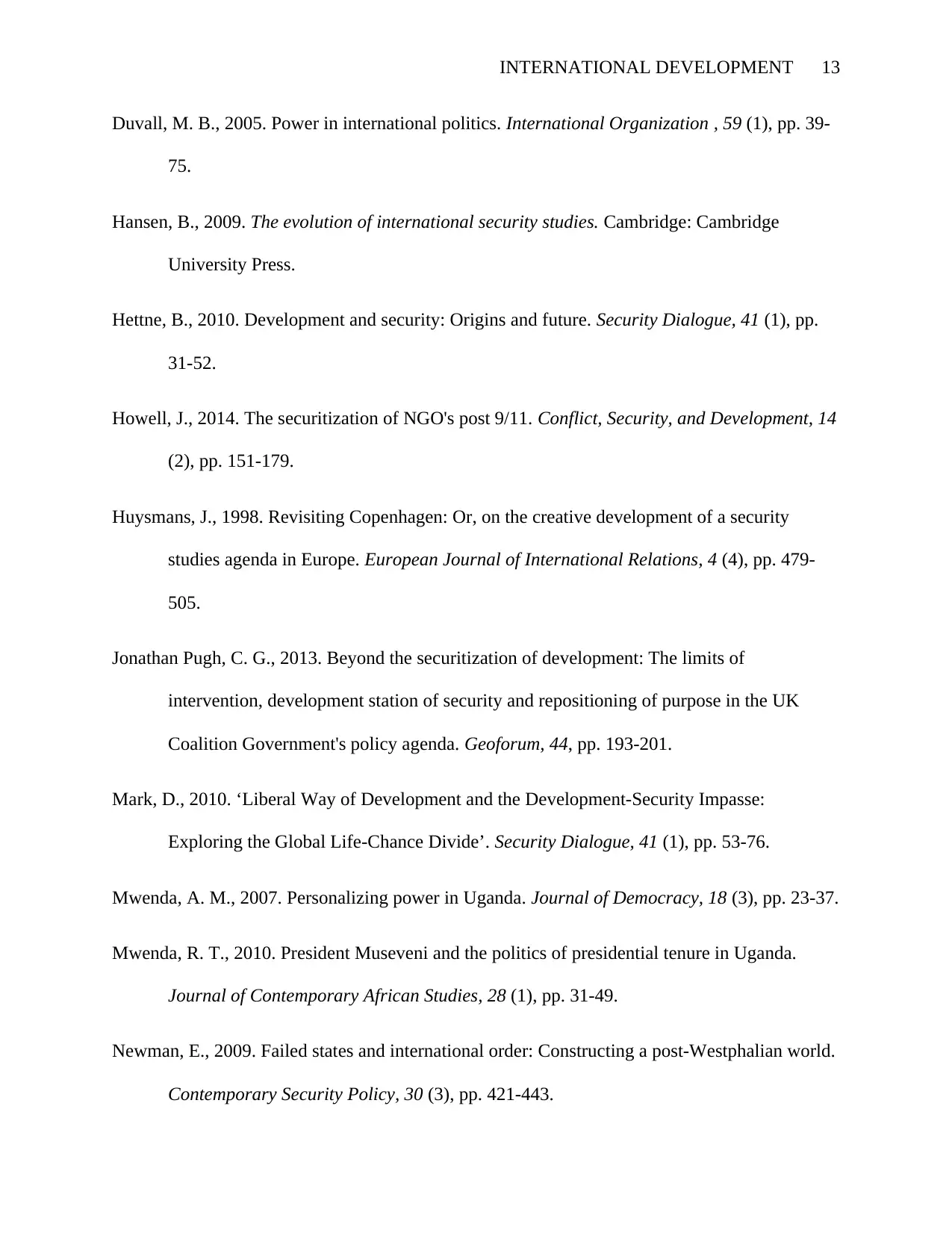
INTERNATIONAL DEVELOPMENT 13
Duvall, M. B., 2005. Power in international politics. International Organization , 59 (1), pp. 39-
75.
Hansen, B., 2009. The evolution of international security studies. Cambridge: Cambridge
University Press.
Hettne, B., 2010. Development and security: Origins and future. Security Dialogue, 41 (1), pp.
31-52.
Howell, J., 2014. The securitization of NGO's post 9/11. Conflict, Security, and Development, 14
(2), pp. 151-179.
Huysmans, J., 1998. Revisiting Copenhagen: Or, on the creative development of a security
studies agenda in Europe. European Journal of International Relations, 4 (4), pp. 479-
505.
Jonathan Pugh, C. G., 2013. Beyond the securitization of development: The limits of
intervention, development station of security and repositioning of purpose in the UK
Coalition Government's policy agenda. Geoforum, 44, pp. 193-201.
Mark, D., 2010. ‘Liberal Way of Development and the Development-Security Impasse:
Exploring the Global Life-Chance Divide’. Security Dialogue, 41 (1), pp. 53-76.
Mwenda, A. M., 2007. Personalizing power in Uganda. Journal of Democracy, 18 (3), pp. 23-37.
Mwenda, R. T., 2010. President Museveni and the politics of presidential tenure in Uganda.
Journal of Contemporary African Studies, 28 (1), pp. 31-49.
Newman, E., 2009. Failed states and international order: Constructing a post-Westphalian world.
Contemporary Security Policy, 30 (3), pp. 421-443.
Duvall, M. B., 2005. Power in international politics. International Organization , 59 (1), pp. 39-
75.
Hansen, B., 2009. The evolution of international security studies. Cambridge: Cambridge
University Press.
Hettne, B., 2010. Development and security: Origins and future. Security Dialogue, 41 (1), pp.
31-52.
Howell, J., 2014. The securitization of NGO's post 9/11. Conflict, Security, and Development, 14
(2), pp. 151-179.
Huysmans, J., 1998. Revisiting Copenhagen: Or, on the creative development of a security
studies agenda in Europe. European Journal of International Relations, 4 (4), pp. 479-
505.
Jonathan Pugh, C. G., 2013. Beyond the securitization of development: The limits of
intervention, development station of security and repositioning of purpose in the UK
Coalition Government's policy agenda. Geoforum, 44, pp. 193-201.
Mark, D., 2010. ‘Liberal Way of Development and the Development-Security Impasse:
Exploring the Global Life-Chance Divide’. Security Dialogue, 41 (1), pp. 53-76.
Mwenda, A. M., 2007. Personalizing power in Uganda. Journal of Democracy, 18 (3), pp. 23-37.
Mwenda, R. T., 2010. President Museveni and the politics of presidential tenure in Uganda.
Journal of Contemporary African Studies, 28 (1), pp. 31-49.
Newman, E., 2009. Failed states and international order: Constructing a post-Westphalian world.
Contemporary Security Policy, 30 (3), pp. 421-443.
Paraphrase This Document
Need a fresh take? Get an instant paraphrase of this document with our AI Paraphraser
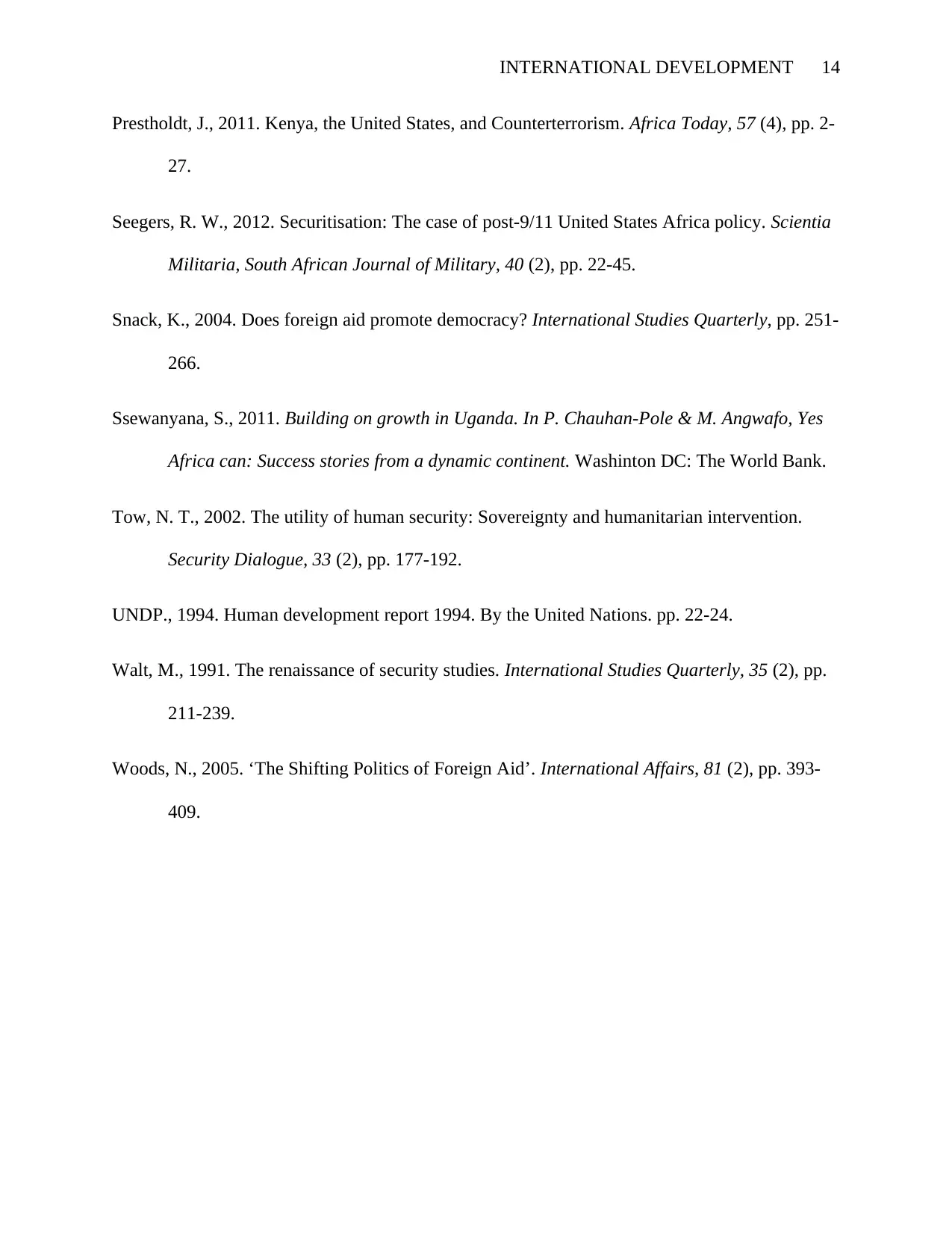
INTERNATIONAL DEVELOPMENT 14
Prestholdt, J., 2011. Kenya, the United States, and Counterterrorism. Africa Today, 57 (4), pp. 2-
27.
Seegers, R. W., 2012. Securitisation: The case of post-9/11 United States Africa policy. Scientia
Militaria, South African Journal of Military, 40 (2), pp. 22-45.
Snack, K., 2004. Does foreign aid promote democracy? International Studies Quarterly, pp. 251-
266.
Ssewanyana, S., 2011. Building on growth in Uganda. In P. Chauhan-Pole & M. Angwafo, Yes
Africa can: Success stories from a dynamic continent. Washinton DC: The World Bank.
Tow, N. T., 2002. The utility of human security: Sovereignty and humanitarian intervention.
Security Dialogue, 33 (2), pp. 177-192.
UNDP., 1994. Human development report 1994. By the United Nations. pp. 22-24.
Walt, M., 1991. The renaissance of security studies. International Studies Quarterly, 35 (2), pp.
211-239.
Woods, N., 2005. ‘The Shifting Politics of Foreign Aid’. International Affairs, 81 (2), pp. 393-
409.
Prestholdt, J., 2011. Kenya, the United States, and Counterterrorism. Africa Today, 57 (4), pp. 2-
27.
Seegers, R. W., 2012. Securitisation: The case of post-9/11 United States Africa policy. Scientia
Militaria, South African Journal of Military, 40 (2), pp. 22-45.
Snack, K., 2004. Does foreign aid promote democracy? International Studies Quarterly, pp. 251-
266.
Ssewanyana, S., 2011. Building on growth in Uganda. In P. Chauhan-Pole & M. Angwafo, Yes
Africa can: Success stories from a dynamic continent. Washinton DC: The World Bank.
Tow, N. T., 2002. The utility of human security: Sovereignty and humanitarian intervention.
Security Dialogue, 33 (2), pp. 177-192.
UNDP., 1994. Human development report 1994. By the United Nations. pp. 22-24.
Walt, M., 1991. The renaissance of security studies. International Studies Quarterly, 35 (2), pp.
211-239.
Woods, N., 2005. ‘The Shifting Politics of Foreign Aid’. International Affairs, 81 (2), pp. 393-
409.
1 out of 14
Related Documents
Your All-in-One AI-Powered Toolkit for Academic Success.
+13062052269
info@desklib.com
Available 24*7 on WhatsApp / Email
![[object Object]](/_next/static/media/star-bottom.7253800d.svg)
Unlock your academic potential
© 2024 | Zucol Services PVT LTD | All rights reserved.



